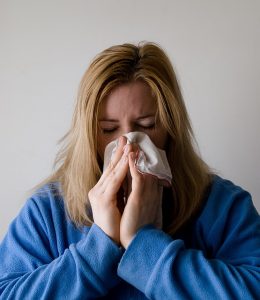Each fall launches the beginning of a new flu season, a highly contagious illness caused by the Influenza virus that may cause symptoms like fever, chills, sore throat, body and headaches, and a cough that can continue for weeks after you have recovered.1,2
In a foodservice environment, employee sickness and absenteeism due to the flu can lead to poor guest experience—or worse, an outbreak of illness.
Avoiding contact with infected persons is the best way to prevent virus transmission, however, studies show that many employees still come to work when sick. A 2014 report from the Centers for Disease Control and Prevention (CDC) indicates that food service workers suffer from the highest incidence of the flu in US workers.3
Another CDC report found that 12% of employees reported working and serving meals while they were sick and experiencing vomiting or diarrhea4 – an obvious risk to food safety.

In addition to creating a food safety culture that discourages sick employees from coming into the workplace, there are a few simple steps that foodservice establishments can take to prevent the spread of the flu inside their establishment:
Vaccinate – To minimize absenteeism, The CDC states that getting vaccinated is the first step in preventing the spread of illness.5 While you may not be able to mandate that your employees get vaccinated, you can encourage them to do so by offering to pay for the vaccination or even hosting a vaccination day.
Hand Hygiene – This is one of the easiest ways to defend against the flu and should be our second line of defense after vaccination. The list of times when employees are required to wash their hands is long and varied, and includes after using the restroom, smoking, touching their face, eating, drinking, sneezing, and before putting on gloves. Employees inevitably overlook some of these key hand-hygiene times, especially during peak business hours; however, a diligent manager with a strong handwashing policy and a workspace with easy access to handwashing sinks can make a big difference in employee compliance.6In environments where soap and running water may not be readily available, the CDC recommends an alcohol-based hand sanitizer for hand disinfection. 7
Disinfect Surfaces – The flu virus can survive for several hours outside the human body, meaning high touch surfaces such as tables, hand rails, and door handles can easily spread germs between employees and guests. These surfaces should follow a proper disinfecting protocol with a disinfecting product effective against the flu and other common pathogens.
Vaccinating, enforcing hand hygiene, and disinfecting surfaces are the three key steps in preventing the spread of illness amongst both employees and customers, as well as minimizing employee absenteeism.
When employees are sick, they need to be sent home or allowed to call out. The Occupational Safety and Health Administration (OSHA) guidelines mandate that employees be provided with a safe and healthful workplace, and that employers should create policies that encourage employees to stay home when sick without penalty.8
Fighting the flu is everyone’s responsibility, so please use the resources highlighted in this article to build the policies that work for your workplace. To request more information about how Sani Professional® products can help improve your cleaning, sanitizing, disinfecting, and hand hygiene procedures please contact us.
References:
1 https://www.cdc.gov/flu/consumer/symptoms.htm
2 http://journal.chestnet.org/article/S0012-3692(15)52842-0/fulltext
3 http://www.safetyandhealthmagazine.com/articles/10079-CDC-Flu-most-prevalent-among-real-estate-food-service-workers
4 https://www.cdc.gov/nceh/ehs/ehsnet/plain_language/food-workers-working-when-sick.htm
5 https://www.cdc.gov/flu/pdf/business/toolkit_seasonal_flu_for_businesses_and_employers.pdf
6 https://www.foodsafetymagazine.com/magazine-archive1/december-2007january-2008/good-handwashing-is-management-101/
7 https://www.cdc.gov/handwashing/show-me-the-science-hand-sanitizer.html
8 https://www.osha.gov/dts/guidance/flu/nonhealthcare.html

